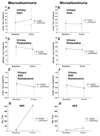Early urinary markers of diabetic kidney disease: a nested case-control study from the Diabetes Control and Complications Trial (DCCT)
- PMID: 20138413
- PMCID: PMC2864367
- DOI: 10.1053/j.ajkd.2009.11.009
Early urinary markers of diabetic kidney disease: a nested case-control study from the Diabetes Control and Complications Trial (DCCT)
Abstract
Background: Urinary markers were tested as predictors of macroalbuminuria or microalbuminuria in patients with type 1 diabetes.
Study design: Nested case-control of participants in the Diabetes Control and Complications Trial (DCCT).
Setting & participants: 87 cases of microalbuminuria were matched to 174 controls in a 1:2 ratio, while 4 cases were matched to 4 controls in a 1:1 ratio, resulting in 91 cases and 178 controls for microalbuminuria. 55 cases of macroalbuminuria were matched to 110 controls in a 1:2 ratio. Controls were free of micro-/macroalbuminuria when their matching case first developed micro-/macroalbuminuria.
Predictors: Urinary N-acetyl-beta-d-glucosaminidase (NAG), pentosidine, advanced glycation end product (AGE) fluorescence, and albumin excretion rate (AER).
Outcomes: Incident microalbuminuria (2 consecutive annual AERs > 40 but < or = 300 mg/d) or macroalbuminuria (AER > 300 mg/d).
Measurements: Stored urine samples from DCCT entry and 1-9 years later when macro- or microalbuminuria occurred were measured for the lysosomal enzyme NAG and the AGE pentosidine and AGE fluorescence. AER and adjustor variables were obtained from the DCCT.
Results: Submicroalbuminuric AER levels at baseline independently predicted microalbuminuria (adjusted OR, 1.83; P < 0.001) and macroalbuminuria (adjusted OR, 1.82; P < 0.001). Baseline NAG excretion independently predicted macroalbuminuria (adjusted OR, 2.26; P < 0.001) and microalbuminuria (adjusted OR, 1.86; P < 0.001). Baseline pentosidine excretion predicted macroalbuminuria (adjusted OR, 6.89; P = 0.002). Baseline AGE fluorescence predicted microalbuminuria (adjusted OR, 1.68; P = 0.02). However, adjusted for NAG excretion, pentosidine excretion and AGE fluorescence lost the predictive association with macroalbuminuria and microalbuminuria, respectively.
Limitations: Use of angiotensin-converting enzyme inhibitors was not directly ascertained, although their use was proscribed during the DCCT.
Conclusions: Early in type 1 diabetes, repeated measurements of AER and urinary NAG excretion may identify individuals susceptible to future diabetic nephropathy. Combining the 2 markers may yield a better predictive model than either one alone. Renal tubule stress may be more severe, reflecting abnormal renal tubule processing of AGE-modified proteins, in individuals susceptible to diabetic nephropathy.
Published by Elsevier Inc.
Figures

Comment in
-
Urinary tubular biomarkers of kidney damage: potential value in clinical practice.Am J Kidney Dis. 2010 May;55(5):813-6. doi: 10.1053/j.ajkd.2010.02.002. Am J Kidney Dis. 2010. PMID: 20438985 No abstract available.
Similar articles
-
Dissociation between urinary pyrraline and pentosidine concentrations in diabetic patients with advanced nephropathy.J Lab Clin Med. 2004 Aug;144(2):92-9. doi: 10.1016/j.lab.2004.03.016. J Lab Clin Med. 2004. PMID: 15322503
-
Albuminuria Changes and Cardiovascular and Renal Outcomes in Type 1 Diabetes: The DCCT/EDIC Study.Clin J Am Soc Nephrol. 2016 Nov 7;11(11):1969-1977. doi: 10.2215/CJN.02870316. Epub 2016 Oct 24. Clin J Am Soc Nephrol. 2016. PMID: 27797889 Free PMC article.
-
Urinary albumin excretion rate and glomerular filtration rate in the prediction of diabetic nephropathy; a long-term follow-up study of childhood onset type-1 diabetic patients.Nephrol Dial Transplant. 2001 Jul;16(7):1382-6. doi: 10.1093/ndt/16.7.1382. Nephrol Dial Transplant. 2001. PMID: 11427629
-
[How I evaluate...diabetic nephropathy. First part: micro- and macroalbuminuria].Rev Med Liege. 1998 Aug;53(8):494-8. Rev Med Liege. 1998. PMID: 9810212 Review. French.
-
The importance of microalbuminuria as an indicator of incipient diabetic nephropathy: therapeutic implications.Ann Med. 1997 Oct;29(5):439-45. doi: 10.3109/07853899708999374. Ann Med. 1997. PMID: 9453292 Review.
Cited by
-
Glycated peptides are associated with proximal tubule dysfunction in type 2 diabetes mellitus.Int J Clin Exp Med. 2015 Feb 15;8(2):2516-25. eCollection 2015. Int J Clin Exp Med. 2015. PMID: 25932197 Free PMC article.
-
Glomerular and tubular damage markers in individuals with progressive albuminuria.Clin J Am Soc Nephrol. 2013 Jul;8(7):1106-14. doi: 10.2215/CJN.04510512. Epub 2013 Mar 28. Clin J Am Soc Nephrol. 2013. PMID: 23539232 Free PMC article.
-
Up-Date on Diabetic Nephropathy.Life (Basel). 2022 Aug 8;12(8):1202. doi: 10.3390/life12081202. Life (Basel). 2022. PMID: 36013381 Free PMC article. Review.
-
Hyperinsulinemia contributes to impaired-glucose-tolerance-induced renal injury via mir-7977/SIRT3 signaling.Ther Adv Chronic Dis. 2020 May 8;11:2040622320916008. doi: 10.1177/2040622320916008. eCollection 2020. Ther Adv Chronic Dis. 2020. PMID: 32523663 Free PMC article.
-
Biomarkers in diabetic nephropathy: Present and future.World J Diabetes. 2014 Dec 15;5(6):763-76. doi: 10.4239/wjd.v5.i6.763. World J Diabetes. 2014. PMID: 25512779 Free PMC article. Review.
References
-
- Krolewski M, Eggers PW, Warram JH. Magnitude of end-stage renal disease in IDDM: a 35 year follow-up study. Kidney Int. 1996 Dec;50(6):2041–2046. - PubMed
-
- The Diabetes Control and Complications Trial Research Group. The effect of intensive treatment of diabetes on the development and progression of long-term complications in insulin-dependent diabetes mellitus. N Engl J Med. 1993;329(14):977–986. - PubMed
-
- The Diabetes Control and Complications Trial Research Group. Clustering of long-term complications in families with diabetes in the diabetes control and complications trial. Diabetes. 1997 Nov;46(11):1829–1839. - PubMed
-
- Genuth S, Sun W, Cleary P, et al. Glycation and carboxymethyllysine levels in skin collagen predict the risk of future 10-year progression of diabetic retinopathy and nephropathy in the diabetes control and complications trial and epidemiology of diabetes interventions and complications participants with type 1 diabetes. Diabetes. 2005 Nov;54(11):3103–3111. - PMC - PubMed
-
- Beisswenger PJ, Drummond KS, Nelson RG, Howell SK, Szwergold BS, Mauer M. Susceptibility to diabetic nephropathy is related to dicarbonyl and oxidative stress. Diabetes. 2005 Nov;54(11):3274–3281. - PubMed
Publication types
MeSH terms
Substances
Grants and funding
LinkOut - more resources
Full Text Sources
Medical

